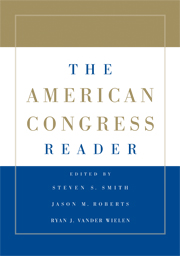Book contents
- Frontmatter
- Contents
- THE AMERICAN CONGRESS READER
- PART I THE AMERICAN CONGRESS: MODERN TRENDS
- PART II REPRESENTATION AND LAWMAKING IN CONGRESS: THE CONSTITUTIONAL AND HISTORICAL CONTEXT
- PART III CONGRESSIONAL ELECTIONS AND POLICY ALIGNMENTS
- PART IV MEMBERS, GOALS, RESOURCES, AND STRATEGIES
- PART V PARTIES AND LEADERS
- PART VI THE STANDING COMMITTEES
- PART VII THE RULES OF THE LEGISLATIVE GAME
- PART VIII THE FLOOR AND VOTING
- 25 Greasing the Wheels
- 26 Models of Legislative Voting
- 27 Pivotal Politics
- PART IX CONGRESS AND THE PRESIDENT
- PART X CONGRESS AND THE COURTS
- PART XI CONGRESS, LOBBYISTS, AND INTEREST GROUPS
- PART XII CONGRESS AND BUDGET POLITICS
- PART XIII FURTHER READINGS ON CONGRESSIONAL POLITICS
26 - Models of Legislative Voting
Published online by Cambridge University Press: 05 June 2012
- Frontmatter
- Contents
- THE AMERICAN CONGRESS READER
- PART I THE AMERICAN CONGRESS: MODERN TRENDS
- PART II REPRESENTATION AND LAWMAKING IN CONGRESS: THE CONSTITUTIONAL AND HISTORICAL CONTEXT
- PART III CONGRESSIONAL ELECTIONS AND POLICY ALIGNMENTS
- PART IV MEMBERS, GOALS, RESOURCES, AND STRATEGIES
- PART V PARTIES AND LEADERS
- PART VI THE STANDING COMMITTEES
- PART VII THE RULES OF THE LEGISLATIVE GAME
- PART VIII THE FLOOR AND VOTING
- 25 Greasing the Wheels
- 26 Models of Legislative Voting
- 27 Pivotal Politics
- PART IX CONGRESS AND THE PRESIDENT
- PART X CONGRESS AND THE COURTS
- PART XI CONGRESS, LOBBYISTS, AND INTEREST GROUPS
- PART XII CONGRESS AND BUDGET POLITICS
- PART XIII FURTHER READINGS ON CONGRESSIONAL POLITICS
Summary
Kingdon explores why members of Congress make the voting decisions they do. He finds that many members employ cues from their party, members of their state delegation, and relevant interest groups in deciding how to vote on bills.
THE MODELS
Identifying and describing models of legislative voting is not an easy task, as it turns out. There is actually quite a large number of constructs and arguments abroad in the literature which could be considered to be implicit or explicit models of voting. Our first task is to identify a set of models that do purport to be representations of decision processes involved in legislative voting and to summarize their major features. It is impossible in these pages to go into sufficient detail to do full justice to their richness and complexity. Nor is it my purpose to enter into a detailed critique of each model. But I will briefly state the major approach of each model without, I hope, doing violence to its intent.
Cue-Taking
Best exemplified by the Matthews–Stimson model, cue-taking starts with the assumption that legislators must somehow cut their great information costs in order to reach decisions that will further their goals. The dominant strategy for accomplishing this is turning to their colleagues within the legislative body for cues which they follow in voting. These cues may come from individual legislators or from such groups of them as the state party delegation, the party, or even the whole body.
- Type
- Chapter
- Information
- The American Congress Reader , pp. 292 - 306Publisher: Cambridge University PressPrint publication year: 2008

